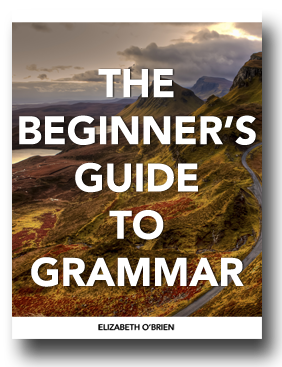Download your free grammar guide here.
Download your free grammar guide here.
When do you need a comma between adjectives?
When do you need a comma between adjectives?
- Home
- Punctuation
- Comma Between Adjectives
Have you ever wondered when you need to use a comma between adjectives? Some adjectives should have a comma between them and others shouldn't.
1. Three furry cats cuddled on my lap.
2. We walked down the long, narrow path.
Why do we use a comma between the adjectives long and narrow in sentence two, but not between the adjectives three and furry in sentence one?
If you've ever Googled this question, you've probably landed on an article stating this rule: use a comma between coordinate adjectives.
That rule sounds simple, but it's a bit hard to apply because no one knows what a coordinate adjective is!
Let's untangle this one together.
But First ... What Are Adjectives?
Before we explore coordinate adjectives, let's have a little refresher on adjectives.
Adjectives are words that describe nouns and pronouns.
The wise, handsome owl had orange eyes.
They usually answer the adjective questions.
Which one? What kind? How many? Whose?
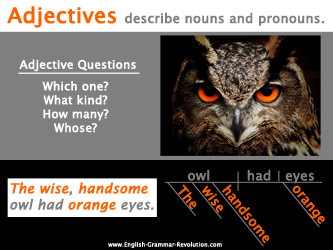
What Are Coordinate Adjectives?
Coordinate Adjectives
Coordinate adjectives modify the same noun independent of each other. They hold equal weight.
They perfectly fit the definition of coordinate!
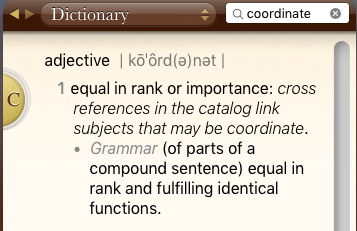
We walked down the long, narrow path.
Long and narrow are modifying the noun path independent of each other. Long is modifying path, and narrow is modifying path.
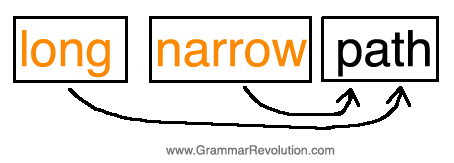 This is how coordinate adjectives work.
This is how coordinate adjectives work.If adjectives are coordinate, put a comma or the word and between them.
This lesson might not be very helpful yet, but stay with me because the magic is about to happen! One way to learn about what something is is to learn about what something isn't. So, our next question is As opposed to what? How else would an adjective modify a noun?
Enter: cumulative adjectives
Are you tired of second-guessing your punctuation?
Let's fix that!
Imagine writing an email, a lesson plan, or even a professional document without stopping to question whether you’re using a comma, dash, or colon correctly.
Lifetime access. One-time payment. No subscriptions. No overwhelm. Click here to learn more! 💛
What Are Cumulative Adjectives?
Cumulative Adjectives
These adjectives also live up to their name.
Cumulative adjectives describe, not only the noun, but the combination of the next adjective and the noun.
Cumulative adjectives build upon one another to modify a noun.
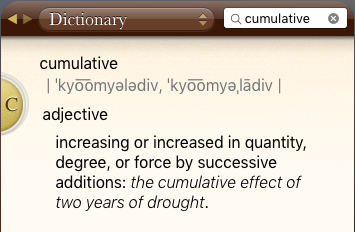
Three furry cats cuddled on my lap.
Although it might not seem like it, three and furry are modifying the noun cats differently. Furry is modifying just the noun cats, and three is modifying the phrase furry cats.
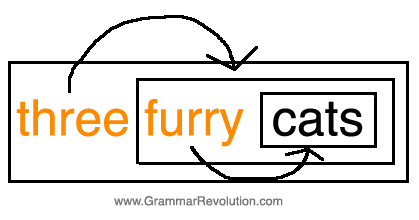 This is how cumulative adjectives work.
This is how cumulative adjectives work.If adjectives are cumulative, don't put a comma between them. That would break up their cumulative effect!
Tests For Identifying Coordinate Adjectives
It's not always easy to identify adjectives as coordinate or cumulative, but there are two tests that we can apply in order to help us figure it out.
A Note To Non-Native Speakers
The drawback of these tests is that they rely on the sentence "sounding normal" or not. If English isn't your native language, these tests may not be very helpful for you because you may not have enough experience with what "sounds normal" and what doesn't. Proceed with caution!
Test 1. The And Test
If you can't tell whether your adjectives are coordinate or cumulative, try putting and between them. If your sentence sounds normal, you have coordinate adjectives, and they need a comma between them. If your sentence sounds strange, you have cumulative adjectives, and you shouldn't use a comma.
Three and furry cats cuddled on my lap. --> No
This doesn't sound good. Three and furry are cumulative adjectives. They shouldn't have a comma between them.
Three furry cats cuddled on my lap. --> Yes
Let's apply this test to our other example sentence.
We walked down the long and narrow path. --> Yes
This sounds good. These are coordinate adjectives, and we should use a comma or the word and between them.
We walked down the long, narrow path. --> Yes
Why does this test work?
The word and is a coordinating conjunction. Coordinating conjunctions join sentence elements that are the same. Coordinate adjectives have equal weight in modifying the noun, and they do so independently, so it makes sense that we can use and between them.
Test 2. The Order Test
Try reversing the order of the adjectives. If the sentence still sounds normal, then you have coordinate adjectives, and they need a comma between them. If your sentence sounds strange, then you have cumulative adjectives, and you shouldn't use a comma.
Furry three cats cuddled on my lap. --> No
This doesn't sound normal. These are cumulative adjectives, so there shouldn't be a comma between them.
Three furry cats cuddled on my lap. --> Yes
Let's apply this test to our second example sentence.
We walked down the narrow, long path. --> Yes
This still sounds okay. These are coordinate adjectives, and there should be a comma between them.
We walked down the long, narrow path. --> Yes
Why does this test work?
Cumulative adjectives are used in a certain order so they sound funny when you switch them around. That's not true for coordinate adjectives. Coordinate adjectives can be used in any order. This PDF has information on the order of adjectives.
Does Sentence Diagramming Help?
You know that I love diagramming sentences, so you might be wondering if diagramming these adjectives will help you figure out if they are coordinate or cumulative.
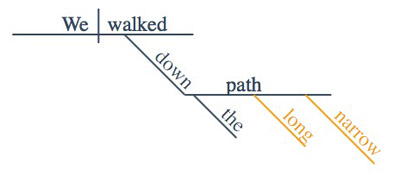 Coordinate Adjectives
Coordinate Adjectives Cumulative Adjectives
Cumulative AdjectivesAs you can see, all of the adjectives are diagrammed in the same way. Unfortunately, one limitation of sentence diagramming is that, although these adjectives function differently, we diagram them in the same way, so diagramming these sentences won't help you figure out whether or not you need a comma.
Whew! You made it with me all the way to the bottom of the page! Since you had the tenacity to read through this whole lesson, I think that you deserve a gold star. This is for you.
Are you tired of second-guessing your punctuation?
Let's fix that!
Imagine writing an email, a lesson plan, or even a professional document without stopping to question whether you’re using a comma, dash, or colon correctly.
Lifetime access. One-time payment. No subscriptions. No overwhelm. Click here to learn more! 💛
If you'd like to teach or learn grammar the easy way—with sentence diagrams—check out our Get Smart Grammar Program.
It starts from the very beginning and teaches you grammar and sentence diagramming in easy, bite-size lessons.

Hello! I'm Elizabeth O'Brien, and my goal is to get you jazzed about grammar.
This is original content from https://www.english-grammar-revolution.com/comma-and-adjectives.html
Our Free Guide Gives You A Fun Way
To Teach And Learn The Basics v

Elizabeth O'Brien is the creator of Grammar Revolution.
Her lessons are guaranteed to give you more confidence in your communication skills and make you smile. :)

